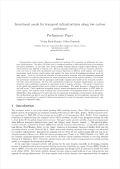
Transportation mode choices, distances traveled and resulting CO2 emissions are influenced by transport infrastructures. The latter will either lock-in transport patterns in high-emitting modes or accompany low-carbon pathways. At the same time, future mobility demand increase requires rapid build-up of new infrastructures and upgrade of existing ones. Here the authors quantify investments needs for transport infrastructures over time to reach both development and climate objectives in different world regions. Investments needs between world regions are compared and the main factors determining investment needs for each region are analyzed. To do so, the authors build an ensemble of socio-economic scenarios with the integrated assessment model Imaclim-R combining alternatives on model parameters determining mobility patterns. The authors estimate the investments consistent with the passengers and freight transportation trends in the scenarios and identify their main determinants.

Climate change will affect all types of infrastructure, including energy, transport and water. Rising temperatures, increased flood risk and other potential hazards will threaten the reliable and efficient operation of these networks, with potentially large economic and social impacts. Decisions made now about the design, location and operation of infrastructure will determine how resilient they will be to a changing climate.
This paper provides a framework for action aimed at national policymakers in OECD countries to help them ensure new and existing infrastructure is resilient to climate change. It examines national governments’ action in OECD countries, and provides recent insights from professional and industry associations, development banks and other financial institutions on how to make infrastructure more resilient to climate change.
Low-carbon, 'green' economic growth is necessary to simultaneously improve human welfare and avoid the worst impacts of climate change and environmental degradation. Infrastructure choices underpin both the growth and the carbon intensity of the economy. This Perspective explores the barriers to investing in low-carbon infrastructure and some of the policy levers available to overcome them. The barriers to decarbonizing infrastructure 'nest' within a set of barriers to infrastructure development more generally that cause spending on infrastructure—low-carbon or not—to fall more than 70% short of optimal levels. Developing countries face additional barriers such as currency and political risks that increase the investment gap. Low-carbon alternatives face further barriers, such as commercialization risk and financial and public institutions designed for different investment needs. While the broader barriers to infrastructure investment are discussed in other streams of literature, they are often disregarded in literature on renewable energy diffusion or climate finance, which tends to focus narrowly on the project costs of low- versus high-carbon options.
This paper highlights the suitability of multilateral development banks (MDBs) for infrastructure financing, to provide the long-term financing needed for infrastructure investment to become profitable, given the large scale of the initial investment and the long amortization time. This paper outlibes giw MDBs can offer finance at a relatively low cost due to their high credit ratings. Thus, they can borrow relatively cheaper on the international capital markets and pass on that cost advantage to their borrowers. However, the authors note that MDBs face some restrictions in their ability to provide support to infrastructure, but nonetheless have numerous advantages in terms of financial terms, information, and ability to cope with risk, all of which can play a significant catalytic role. The paper is divided into the followig sub-sections: i) Loans (long tenors and big tickets) and Equity, ii) Technical Assistance, iii) New Partners, iv) Unfunded Instruments and v) Proved and Tested Instruments vs. New Instruments. And in conclusion, the authors present key findings from this study.
This paper examines investments—in the form of equity or debt—in direct investments to infrastructure. It first introduces the pros and cons of project finance instrument. After that, it analyses infrastructure projects as a nexus of contracts and pool of risks. It then highlights the most important variables that investors look at when deciding to invest money in infrastructure projects. Followed by that, it draws conclusions and identifies some possible implications for the design of the business model of a newly created multilateral bank for Brazil, Russia, India, China, and South Africa (BRICS) countries.
This paper is part of the working paper series "Infrastructure Finance in the Developing World" and is a joint research effort by GGGI and the G-24, exploring the challenges and opportunities for scaling up infrastructure finance in emerging markets and developing countries.
